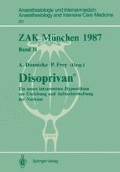Zusammenfassung
Untersucht wurden bei 20 geriatrischen Patienten (Alter 65–82 J.), die sich einem Oberbaucheingriff unterzogen, die Wirkungen von Propofol und Etomidat auf die allgemeine und koronare Hämodynamik sowie den myokardialen Sauerstoffverbrauch. 10 Patienten erhielten zur Einleitung 1,5 mg/kg KG Propofol, gefolgt von einer 10minütigen Infusion einer der Einleitungsdosis entsprechenden Menge und anschließender kontinuierlicher Zufuhr von 0,1 mg/kg/min. Bei den übrigen 10 Patienten wurde die Narkose mit 18 mg Etomidat eingeleitet und mit 2,4 mg/min aufrechterhalten. Die Muskelrelaxierung erfolgte mit Vecuronium. Kardiovaskuläre Parameter wurden im Wachzustand sowie 1 min nach der Einleitung und 1, 5 und 30 min nach der endotrachealen Intubation gemessen, die Koronardurchblutung (Argon-Aufsättigungsmethode) und der myokardiale Sauerstoffverbrauch im Wachzustand sowie 5 und 30 min nach der Intubation. Beide Anästhetika verminderten die systolischen, diastolischen und mittleren arteriellen Drücke sowie die Herzfrequenz und den Herzindex in vergleichbarem Ausmaß. Der myokardiale Sauerstoffverbrauch und, parallel hierzu, die Koronardurchblutung nahmen ab, bedingt durch die verminderte Herzarbeit. Die endotracheale Intubation bewirkte in der Etomidatgruppe einen ausgeprägten Blutdruckanstieg, während in der Propofolgruppe keine signifikanten Änderungen auftraten. Eine myokardiale Laktatfreisetzung als Zeichen der Myokardischämie wurde in keiner Gruppe beobachtet.
Hohes Alter geht mit einer Einschränkung der kardiovaskulären Reserve einher. Daher ist bei geriatrischen Patienten eine sorgfältige Auswahl der Anästhetika erforderlich, um eine übermäßige Beeinträchtigung der Herz-KreislaufFunktion zu vermeiden. Etomidat beeinflußt die allgemeine und koronare Hämodynamik sonst gesunder Patienten nur in geringem Maße [1] und wird daher häufig in der geriatrischen Anästhesie sowie bei Patienten mit Herz-KreislaufErkrankungen eingesetzt. Allerdings unterdrückt diese Substanz bei einem umschriebenen Prozentsatz chirurgischer Patienten die kardiovaskulären Reaktionen auf verschiedene Stimuli nicht ausreichend, so daß der Einsatz bei geriatrischen Patienten begrenzt wird. Propofol wiederum bewirkt gewöhnlich einen Abfall des mittleren arteriellen Blutdrucks, der offenbar dosisabhängig ist und durch Herzklappenerkrankungen oder koronare Herzkrankheit verstärkt wird [4–6]; andererseits werden hämodynamische Reaktionen bei der endotrachealen Intubation oder Sternotomie durch Propofol weitgehend unterdrückt [5, 6].
In der vorliegenden Untersuchung sollten die kardiovaskulären und myokardialen Wirkungen von Propofol bei geriatrischen Patienten ohne manifeste Herzerkrankungen mit denen von Etomidat verglichen werden.
Mit Unterstützung der Deutschen Forschungsgemeinschaft, Sonderforschungsbereich 89 Kardiologie Göttingen. Die Arbeit enthält zum Teil unveröffentlichte Ergebnisse der Dissertation von A. Bagdahn.
Access this chapter
Tax calculation will be finalised at checkout
Purchases are for personal use only
Preview
Unable to display preview. Download preview PDF.
Literatur
Sonntag H (1980) Actions of anesthetics on the coronary circulation in normal subjects and patients with. ischemic heart disease. In: Prys-Roberts C (ed) Hypertension, ischemic heart disease, and anesthesia. International Anesthesiology Clinics, vol 18, No 4. Little, Brown and Company, Boston, pp 111–35
Prys-Roberts C, Davies JR, Calverley RK, Goodman NW (1983) Haemodynamic effects of infusions of diisopropyl phenol (ICI 35 868) during nitrous oxide anesthesia in man. Br J Anaesth 55: 105–11
Aun C, Major E (1984) The cardiorespiratory effects of ICI 35 868 in patients with valvular heart disease. Anaesthesia 39: 1096–1100
AI-Khudrai D, Gordon G, Morgan M, Whitwam JG (1982) Acute cardiovascular changes following disoprofol: effects in heavily sedated patients with coronary artery disease. Anaesthesia 37: 1007–10
Patrick MR, Blair IJ, Feneck RO, Sebel PS (1985) A comparison of the haemodynamic effects of propofol („DIPRIVAN“) and thiopentone in patients with coronary artery disease. Postgrad Med J (Suppl 3 ) 61: 23–7
Stephan H, Sonntag H, Schenk HD, Kettler D, Khambatta HI (1986) Effects of propofol on cardiovascular dynamics, myocardial blood flow and myocardial metabolism in patients with coronary artery disease. Br J Anaesth 48: 969–75
Tauchert M, Kochsiek K, Heiss HW (1970) Measurements of coronary blood flow in man by the argon method. In: Maseri A (ed) Myocardial blood flow in man, 1st ed. Minerva Medica, Turin, pp 859–65
Schwilden H, Stoeckel H, Schüttler J, Lauven P (1981) Comparison of various empirical dosage suggestions for etomidate infusions on the basis of pharmacokinetic data. Anästh Intensivther Notfallmed 26: 176–9
Coates DP, Prys-Roberts C, Spelina RK, Monk CG, Norley I (1985) Propofol („Diprivan“) by intravenous infusion with nitrous oxide: dose requirements and haemodynamic effects. Postgrad Med J (Suppl 3 ) 61: 76–9
Ulsamer B, Doenicke A, Laschat M (1986) Propofol in comparison to etomidate for the induction of anesthesia. Anästhesist 35: 535–42
Murday HK, Hack, G, Schüttler J, Heinemann T (1985) Anesthetic consideration in patients undergoing aorto-coronary bypass graft surgery. Comparison of the haemodynamic influence of two recent total intravenous anesthetic techniques. Anästh Intensivther Notfallmed 20: 179–85
Murday HK, Hack G, Hermanns E, Rudolph A (1985) Haemodynamic effects of a combination of etomidate, flunitrazepam or midazolam with fentanyl for induction of anesthesia in patients with valvular lesions of the heart. Anästh Intensivther Notfallmed 20: 175–8
Cummings GC, Dixon J, Kay NH, Windsor JPW, Major E, Morgan M, Sear JW, Spence AA, Stephenson DK (1984) Dose requirements of ICI 35868 ( Propofol, „Diprivan“) in a new formulation for induction of anesthesia. Anaesthesia 39: 1168–71
Hempelmann G, Oster W, Piepenbrock S, Karliczek G (1977) Haemodynamic effects of etomidate–a new hypnotic–in patients with myocardial insufficiency. In: Doenicke A (ed) Etomidate. Springer, Berlin Heidelberg New York, pp 72–80
Editor information
Editors and Affiliations
Rights and permissions
Copyright information
© 1988 Springer-Verlag Berlin Heidelberg
About this chapter
Cite this chapter
Larsen, R., Rathgeber, J., Bagdahn, A., Lange, H., Rieke, H. (1988). Wirkungen von Propofol auf Hämodynamik, Koronardurchblutung und myokardialen Sauerstoffverbrauch geriatrischer Patienten: Ein Vergleich mit Etomidat. In: Doenicke, A., Frey, P. (eds) ZAK München 1987. Anaesthesiologie und Intensivmedizin / Anaesthesiology and Intensive Care Medicine, vol 201. Springer, Berlin, Heidelberg. https://doi.org/10.1007/978-3-642-73573-8_5
Download citation
DOI: https://doi.org/10.1007/978-3-642-73573-8_5
Publisher Name: Springer, Berlin, Heidelberg
Print ISBN: 978-3-540-19136-0
Online ISBN: 978-3-642-73573-8
eBook Packages: Springer Book Archive

